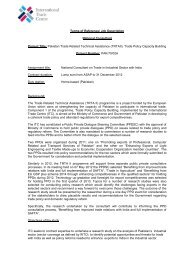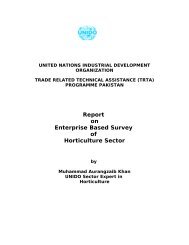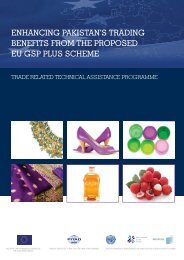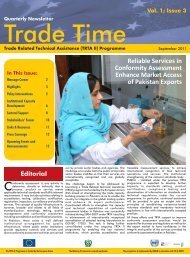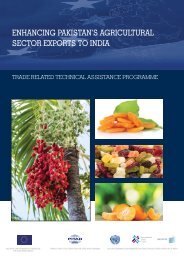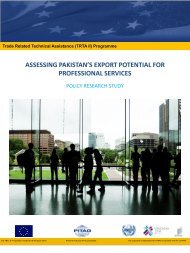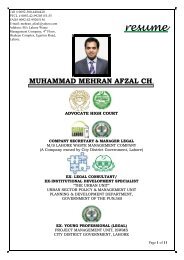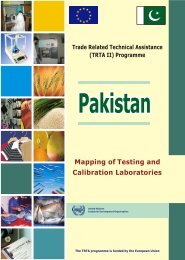Enhancing dairy sector export competitiveness - International Trade ...
Enhancing dairy sector export competitiveness - International Trade ...
Enhancing dairy sector export competitiveness - International Trade ...
You also want an ePaper? Increase the reach of your titles
YUMPU automatically turns print PDFs into web optimized ePapers that Google loves.
ENHANCING DAIRY SECTOR EXPORT COMPETITIVENESS IN PAKISTANIntroductionLivestock breeding has remained a hallmark of the South Asian society since ancient times. Historically,the livestock <strong>sector</strong> has remained a subsistent <strong>sector</strong> where small holders have been raising animals foracquiring meat and milk products mainly for their own consumption and also to receive cash incomethrough small-scale domestic selling. Usually, milk has been considered as the main product of livestockby the urban and rural community as compared to meat from the animals and therefore the animals aregenerally raised for obtaining milk production and making other <strong>dairy</strong> products there from. However thiscontext has lately been changed and now farm animals are also raised on subsistent and commercialscales to sell them for obtaining meat and related products.Pakistan is blessed with a large population of livestock that is well adapted to the local environmentalconditions. Livestock is an important <strong>sector</strong> of Pakistan’s agricultural mix and holds significant value in therural socioeconomic system. More than eight million small and landless rural-based farmers raise livestock;therefore, making it an ideal <strong>sector</strong> for alleviating poverty in the country especially in the rural areas 1 .Furthermore, since livestock makes up almost 55.1% of the agriculture value added and contributes up to11.6% of the GDP 2 , the future high growth in agriculture is expected to be mainly led by the this <strong>sector</strong>.Milk is the major commodity produced by the <strong>dairy</strong> <strong>sector</strong>. Its demand is increasing by an annual averageof 20% (Afzal, 2008) in the organized <strong>dairy</strong> industry which requires milk production and supply to keeppace with the growing demand of the population through maintaining efficient supplies. However, sincemore than 83% of milk animals in the national herd are raised and bred by subsistent farmers who havelimited interest in increasing productivity and have limited outreach to the support institutions in the publicand private <strong>sector</strong>, the overall goal of achieving higher productivity in milk production seems to be adaunting task for the policy makers.Other <strong>dairy</strong> products extracted from milk are also necessary to fulfil nutritional requirements of thepopulation. These include butter, cheese, ghee, yogurt, khoya, and flavoured milk made through the use oftraditional as well as modern methods. Traditional methods are mostly employed by the farmers to fulfiltheir subsistent needs. They also sell these products to support their household income. In the organized<strong>sector</strong>, these products are produced and packed through use of industrial processes and are sold oncommercial scales to the consumers located in various parts of the country. These <strong>dairy</strong> manufacturers arelocated mainly in the province of Punjab and have efficient distribution networks across the country.However, there is a large dependence on imported products in the <strong>dairy</strong> <strong>sector</strong> due to the fact that thequantity, quality and variety of locally produced milk and <strong>dairy</strong> products do not fully cater to the needs ofmasses. The imported milk, mostly in powder form, is also used as an ingredient by many milk processingplants and other producers to produce UHT 3 milk. Besides, imports are used as a balancing tool to bridgedomestic demand and supply gap in milk and milk related products. The powdered milk is imported fromthe United States of America, New Zealand, France, Turkey, Singapore, Australia and some othercountries 4 . In 2011, Pakistan imported powder milk worth US$ 89.12 million from its partner countriesmentioned above 5 .Pakistan is also <strong>export</strong>ing milk in powdered form, but it is mainly to Afghanistan which is facing issues offood security and shortage due to on-going war on terrorism 6 . This powder milk is imported by some largeproducers who re-<strong>export</strong> it to Afghanistan to earn higher profits. Exports of powder milk from Pakistanamounted to US$ 1.82 million to the world in 2011 out of which milk worth US$ 1.77 million was <strong>export</strong>edto Afghanistan. 7 Export of fresh milk from Pakistan is also high particularly to Afghanistan again due to thesame reasons and by the large producers. Pakistan <strong>export</strong>ed fresh milk worth US$ 37.88 million in 2011with 99% being <strong>export</strong>ed to Afghanistan. It is pertinent to mention that <strong>export</strong>ing to Afghanistan is needbased and does not involve Pakistan’s own competence to <strong>export</strong> fresh milk to the world as the country,1 Livestock and Dairy Development Board of Pakistan2 Economic Survey of Pakistan 2011-12, Chapter 2, Agriculture (Islamabad: Official Printer, 2011), 293 Ultra High Temperature: milk that has been heated to a very high temperature so that it stays fresh for longer. Usually it can stayfresh in a tetra package for more than two months unless the pack is opened.4 Other countries include Belgium, Germany, Netherlands, UK, Poland, Ireland, India etc.5 ITC Calculations based on UN COMTRADE Statistics.6 Big companies in the milk production and processing and some other milk dealers are mainly <strong>export</strong>ing imported dry milk toAfghanistan to get profits from the price differential between Pakistan and Afghanistan.7 ITC Calculations based on UN COMTRADE Statistics15



